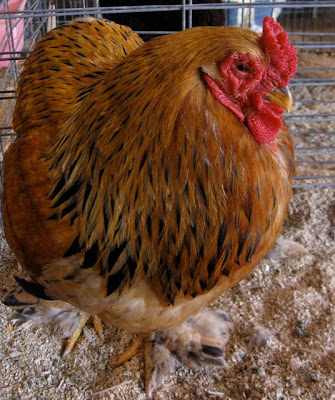 The original look at a Confusing Fall Warbler.
The original look at a Confusing Fall Warbler.
Congratulations to Neil Gilbert, who writes about Orange County Birding in his
OC Birding Blog, for being the first BOTB reader to correctly identify this bird as a bay-breasted warbler. Neil, who is 16, lends further proof to my belief that today's young birders are WAY better informed and knowledgeable than most of the rest of us were (at least those of us older than 35 or so). Check out Neil's blog, too. He gots mad skilz.
 A closer look reveals a bay-breasted warbler, probably a first year female.
A closer look reveals a bay-breasted warbler, probably a first year female.
I know I should be saying here that there's no such thing as a Confusing Fall Warbler. Better birders than I often say that, and I suppose it's true. But I still find myself scratching my head at some of the individual fall warblers that slip through our ridgetop trees here in SE Ohio. If that's not confusion, then I need to change shampoos.
There are three species that, in fall, look a lot like this bird: plain olive-yellow overall with wingbars and some streaking on the breast or back (or both). These three are: pine warbler, bay-breasted warbler, and blackpoll warbler.
At this point you might want to grab your favorite field guide(s) for handy visual reference points. I'd also suggest reading "The Blackpoll Trio" chapter in Kenn Kaufman's excellent book
Advanced Birding.
All of these birds are subtly plumaged, and, in their most confusing versions (first year or hatching year females) they are REALLY similar. Adults are less confusing in fall because they tend to hang on to some of their breeding plumage coloration. Fall adult pine warblers look exactly like breeding plumage birds. Fall adult bay-breasteds of both sexes usually show
some of the rusty "bay" coloration on the flanks (sides). Fall adult blackpolls are flying south over the Atlantic Ocean and are rarely seen inland. But if you DID see one, it would look streaky—and quite similar to breeding plumage adults.
In navigating the murky waters of identification of the "baypolls" as some birders call this trio, you should resist the urge to rely upon one single field mark. But two or three field marks vastly increases your likelihood of making a correct identification.
Let's review a few of the field marks than make this a bay-breasted warbler.
Our bird has definite streaks on the back, which pretty much eliminates pine warbler (which nearly always shows an unstreaked back). A close look at the bill shows it to be relatively thin and finely tipped. Pine warbler bills look stout and more bluntly tipped to me—perfect for a bird that sometimes probes beneath bark for insects. Pine warblers often show an obvious, though small, broken ring (pale in young birds, yellow in adults) around the eye, which this bird does not have. First year female pine warblers are the very definition of dull colored‚ almost gray-brown. Adult pine warblers show a lot of yellow on the throat and breast. This bird (above) shows quite a bit of greenish color, but not much yellow on the throat and breast.
So let's toss out
pine warbler.
mmmK? mmmK!
[For an excellent walk through the identification of a pine warbler, see Jeffrey A. Gordon's recent post about this very thing.]
So, how do we choose between blackpoll and bay-breasted? At this point I often look at the legs and feet. If I get a good look and I see that the bird has pale or yellow feet or legs, I'm leaning toward blackpoll. If the legs seem gray or dark, or if I cannot get a good look, then it could be either.
Next we should look at the streaking. If the bird has noticeable streaking on the breast AND the back, it's most likely to be a blackpoll. The
Sibley guide (page 443) and the new
Peterson guide (page 352) both show this quite well. The
National Geographic guide (page 381) does not—the birds seem too dark to me. (Please don't get me started on the imperfections of printing, a subject about which I am all too experienced.)
Looking at the underparts of a "baypoll" warbler, the quality and location of the color can help steer you toward one species or the other. If the warbler's underparts are relatively uniform in color from throat to undertail (and lacking in streaking, remember?) you almost certainly have a
bay-breasted warbler in your sights. If, however, there is a distinct change from greenish-yellow (near to the throat) to white (on the belly) and there's a little bit of faint streaking on the flanks, you're looking at a blackpoll
warbler. For a nice discussion of this, please read the "Streaky Fall Warblers" chapter on page 296 in
Identify Yourself.
 A first-year blackpoll warbler in fall. Note the streaky breast and the pale legs and feet. Spectacular imagery by Julie Zickefoose.
A first-year blackpoll warbler in fall. Note the streaky breast and the pale legs and feet. Spectacular imagery by Julie Zickefoose.
Here we're using three distinct field marks—
legs/feet, streaking, underparts coloration—to separate bay-breasted warbler from blackpoll warbler. The clues may be subtle, but if you're tuned in to them, the less subtly marked "baypolls" will be easy pickings for you.
I'm no warbler ID expert. But I do know enough to realize that each fall is a chance (for a few short weeks) to "go to school" on the baypolls. I also know that my mind is not a steel trap, so a refresher when these birds are passing through is most useful.



















































